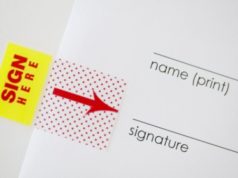
Any time a given party transfers ownership of negotiable instruments to another party, the transferor makes a warranty of certain elements of the negotiable instrument, such that he or she can be held accountable for those elements.
This is true independent of most other forms of liability, which would require a signature or certain conditions such as appropriate presentment of the negotiable instruments, dishonor of those instruments, or notice of dishonor for those instruments. The warranties that arise specifically from the act of transferring the negotiable instrument are called transfer warranties.
There are six different types of transfer warranties, each of which is made when the transferor attempts to transfer any negotiable instruments. The first transfer warranty is that the transferor warrants that he or she is a person entitled to enforce the instrument. The transferor, by transferring any negotiable instruments, is establishing the transfer warranty that he or she is the holder of those instruments or otherwise has the rights of a holder with regard to those instruments.
If the transferor does not actually hold these rights, then the transferor is violating this first transfer warranty with regard to any negotiable instruments that he or she might try to transfer.
The second transfer warranty is that the transferor warrants that all signatures on the negotiable instrument are both authentic and authorized. In other words, simply by transferring negotiable instruments to another party, the transferor is warranting that there are no forged signatures on the negotiable instrument.
Theoretically, the party might not know if there are any unauthentic or forged signatures on the instrument. However, in general, this transfer warranty means that the transferee will be able to seek damages against the transferor if the negotiable instruments being transferred bear forged signatures regardless of the knowledge of that transferor. Although, in that case, the transferor would likely be able to obtain damages from the transferor who originally negotiated the instrument to him or her.
The third transfer warranty is that the negotiable instrument in question has not been altered in any significant or fraudulent fashion. This would include such alterations as attempting to change the amount for which the negotiable instrument is worth.
The fourth transfer warranty is that the transferor warrants that there is no claim of recoupment or defense against payment of the negotiable instrument. If the transferor is a holder in due course and is immune to any such claims, he or she would be able to transfer the negotiable instruments under this transfer warranty. As in the second transfer warranty, having no knowledge of such defenses or claims is not sufficient for protecting oneself from liability under this transfer warranty.
The fifth transfer warranty is that the transferor warrants a lack of knowledge as to any insolvency proceedings being made against the maker, acceptor, or drawer of the negotiable instrument being transferred. Insolvency proceedings would involve any one of those parties being unable to pay off its debts fully and would, therefore, cast doubt upon any negotiable instruments of those parties. In this case, it is acceptable if the transferor simply lacks knowledge of such proceedings.
The sixth transfer warranty deals primarily with remotely made negotiable instruments, such as those instruments that might be made over the phone or, in today’s world, over the Internet. The sixth transfer warranty is that for any negotiable instrument or transaction conducted remotely, the transferor has authorization to have drawn that instrument for that amount from the person on whose account the instrument was drawn.
This warranty is primarily in place to prevent those who sell items over the phone or the Internet from charging consumers fraudulently. Any remotely made negotiable instrument, such as an agreement to pay made over the phone, is warranted as having been made for the amount listed when that instrument is transferred to, say, a bank.

























